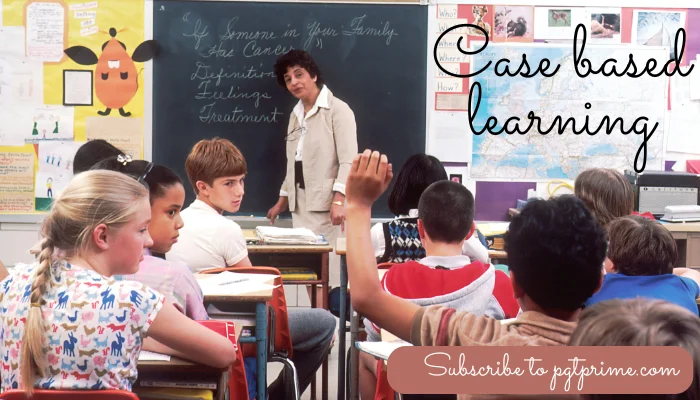Case based Learning (CBL) is an approach that uses real or fictional scenarios to help students apply their knowledge and skills to solve problems or make decisions. It is widely recognized and used in various other disciplines to impart knowledge transfer through an account of a situation that presents a dilemma for the students to analyze and resolve.
NEP 2020 also highlights the importance of Case based learning approach, which compliments experiential learning. Recognizing the challenge of learning solely through doing, this format encourages active learning through team activities and emphsize on practical application of theoretical concepts.
In this approach, skilled tutors guide students by engaging them in dialogue, by encouraging questions and answers. Together, they pinpoint areas that needed improvement, and collaboratively devise solutions to bridge knowledge gaps.
What is Case Based Learning
Case based learning is an in-depth and detailed study of a specific subject such as a person, group, subject, event, organization, or phenomenon. Case based learning is the method of behavior study, in which a particular person has studied his environment as a whole so that information about his behavior and personality can be obtained. It is not used to determine cause and effect or to discover generalizable truths.
Highlight the Importance of Case Based Learning
- This provides an opportunity for students to visualize theory in practice by describing, evaluating, and understanding different aspects of a case study.
- Bringing real-world problems motivates students to develop analytic, collaborative, and communicative skills along with content knowledge.
- Nurtures their decision-making capabilities and prepares them to deal with real-life situations.
Check this out!
😜Did you check our article on “National Common Entrance Test”? Get all necessary information to get admission in NCET 2024: A 4-year Integrated B.Ed Education Program.
Aims and Objectives of Case Based Learning
- To help students explore and describe the nature of processes that occur over time.
- To help students in retaining the holistic and meaningful characteristics of real-life events.
- To help students connect theory and practice, which can deepen their understanding of the subject matter and its relevance to their lives and careers.
- To provide students with feedback and opportunities to learn from their mistakes and successes, which can foster their self-confidence and self-regulation.
- To expose students to diverse perspectives and cultures, which can broaden their horizons and promote their intercultural competence and social responsibility.
- To develop students problem-solving, decision-making, communication, and presentation skills, which can prepare them for future challenges and opportunities.
- To stimulate student’s curiosity and interest, which can encourage them to pursue lifelong learning and continuous improvement.
Check this out!
😜Did you paid attention on EMRS Syllabus 2023? Comeon, start your preparation with EMRS Syllabus 2023.
Use Case Based Learning if
- The outcomes you want the students to achieve are readily related to issues beyond the classroom.
- The students have sufficient prior knowledge to guide and link their analysis to a complex situation.
- The students are self-motivated and can learn with minimal assistance.
- To build student’s confidence by showing the value of their solutions.
- To encourage students to be independent learners.
Check this out!
😜Experiential Learning activities are processes of teaching children by letting them solve real-world situations and absorb their reflections naturally. This seems to be interesting. Check this out in our article Experiential Learning Activities.
Case Based Learning Scenarios
There are six types of methods in case-based learning. There are different types of case studies depending on the purpose, subject, and discipline of the study. Some of the common types of case studies are:
| Description of Case Based Learning |
|---|
| Illustrative Case Study » • These are primarily descriptive studies. • They typically utilize one or two instances of an event to show what a situation is like. • Illustrative case studies serve primarily to make the unfamiliar into familiar and give readers a common language about the topic. |
| Collective Case Study » • In this type of case study-based learning, the researcher studies more than one case i.e. multiple cases to get a better understanding, insight, and information about the complex phenomenon case, and to build the similarities between different cases at a time. • A collective case study uses a common set of research questions to guide the analysis of each case and then synthesizes the results across the cases to draw conclusions and implications. |
| Exploratory Case Study » • Exploratory case study-based learning is only the beginning of an investigation. • Exploratory case studies act as the starting point of studies. • The research is used to suggest why further investigations are needed. • It is used to explore and investigate problems or issues that are not clearly defined. It is conducted to have a better understanding. • This study is not designed to produce detailed data from which any conclusion could be drawn. |
| Critical Instance Case Study » • These studies are used to examine situations of unique interest or to challenge a universal or generalized belief. • A critical instance case study is a type of case study that examines a specific case or phenomenon that has a significant impact or implication for a broader issue, theory, or policy. • It is often used to challenge or test an existing assumption, claim, or generalization, or to provide a unique or rare example of a phenomenon. |
| Cumulative Case study » • It is designed to pull together information for several events or situations and aggregate in such a way that it allows for greater generalization. • It has the advantage of saving time and money by not creating new and repetitive studies. |
| Explanatory Case study» • An explanatory case study is a type of case study that explores how or why a phenomenon occurs. • It is often used to test or challenge an existing theory, assumption, or generalization, or to provide a unique or rare example of a phenomenon. |
Check this out!
😜Educational framework has changed, so is our Xth and XIIth. Update yourself with our article The Dawn of a New Era: National Curriculum Framework 2023.
Case Based Learning Steps
The steps of case study-based learning may vary depending on the purpose, subject, and discipline of the study. However, a general outline of the steps is as follows:
- Deciding a suitable case study or story for students.
- Prepare yourself as an expert tutor for the case discussion.
- Guiding the students in their preparing solutions through a group discussion.
- Try to connect students with multidisciplinary topics and their impact on case studies.
- Develop their ability to work in teams when solving problems.
- Report the findings.

STEP 1: Define the research questions »
- The first step in conducting a case study is to define the research questions that guide the investigation.
- The research questions should be specific, measurable, and relevant to the case study-based learning phenomenon under investigation.
STEP 2: Select the case »
- Once the research problem and research questions are formulated, the expert tutor should select a specific case that you want to focus on.
- The case should be relevant, representative, and interesting for the research problem.
STEP 3: Build a theoretical framework »
- Case-based learning focuses on concrete details rather than general theories.
- Case-based learning should have some connection with the existing theories in the field.
- A literature review is required to understand the case and develop a theoretical framework.
STEP 4: Collect the data »
- Different research methods are used to collect data.
- Case based learning usually focuses on qualitative data, but it can also quantitative data in some cases.
- Qualitative data can be collected through interviews & observation, newspapers, articles, and official records.
- The data should be rich, detailed, and relevant to the case based learning phenomenon. The data collection methods should be appropriate, ethical, and reliable.
STEP 5: Describe & Analyze »
- Integrate all the aspects to give the complete picture of the case under study.
- case based learning can also be written in a narrative style, exploring various angles and analyzing their meanings and implications.
- The analysis should be systematic, rigorous, and transparent. The data analysis should answer the research questions and test the hypotheses.
STEP 6: Report the findings »
- It involves presenting the results and the conclusions of the case study clearly and concisely.
- The findings section should present the main results organized by themes, categories, or patterns. The findings should be supported by evidence from the literature, such as quotes, observations, or documents.
- The findings should also relate to the research questions and the theoretical framework of case based learning.
- The conclusion should summarize the main points of the report, restate the research questions and the purpose of the case study, and provide recommendations or suggestions based on the findings.
Check this out!
😜Do you know, what impacts gross enrolement ratio? Why Govt of India has started FLN Mission 2022.
Benefits of Case Based Learning
What makes Case-based learning unique from other inquiry strategies? Here is the answer:
- It highlights the challenges, risks, and benefits of the process and the outcome. Case studies can showcase the skills, knowledge, and experience of the case study subject and the researcher.
- The case based learning is based on a factual and realistic approach, appropriate for all age levels of students.
- The case based learning is to be aligned with the goals of the class, goals should be well-defined.
- The case based learning is expressed in narrative form and detailed and in-depth analysis of a specific subject.
- It covers a sufficient wide cycle of time and has continuity in nature.
- It studies problems deeply and thoroughly and tries to understand the complex factors that are operative within it as an integrated totality
- The case based learning allows interaction, engages students in discussions, and encourages students to participate in analysis and propose solutions.
- The case based learning states clear dilemmas without solving them, it enhances student’s critical thinking and higher-order thinking.
- Case based learning requires decision making which gives students an active role in the learning process and encourages students to synthesize information from a variety of resources.
Check this out!
😜Pay more attention to this global topic in which Govt of India is interested in. Know all about ECCE.
How to Perform Case Based Learning
How to solve a Case based learning :
- Read the question first and grasp the overview.
- Read and examine the case thoroughly.
- Take notes, highlight relevant facts, and underline key problems from the given case study.
- Think positively that you can solve it.
- Think practically.
- Best alternative solution using theoretical Knowledge.
How to Implement Case Based Learning in School :
To help prospective teachers get familiar with case-based learning or the pedagogy that is presented in the case materials include introductory activities about CBL and provide other necessary background information before discussing and analyzing real cases.
An Instructional Model for Case Based Learning:
| Phase | Activity | Teacher’s role | Student’s role |
| Phase I | • Inquiry focus (authentic & relevant content) | • Select the appropriate case. • Revise the cases to make them more relevant. • Provide case material. | • Read & explore case material Form initial ideas. |
| Phase II | • Prepare discussion & reflection questions. • Set up online discussions. • Explains expectations – read & guide online discussions. | • Select appropriate cases. • Revise the cases to make them more relevant. • Provide case material. | • Explore additional resources. • Participate in online discussions. • Prepare for classroom discussions. |
| Phase III | • Active participation in learning (articulation & scaffolding) | • Scaffolds the classroom discussion. • Keep the discussion on track. • Makes sure questions are answered. | • Engage in classroom discussion. • Takes notes for reflections. • Leads a discussion. |
| Phase IV | • Synthesize key ideas & practices (articulation & reflection) | • Provides rubric for reflection. • Reads, summarizes & shares key points of discussions. • Grades final written reflection. | • Creates final written analysis of the case. • Reflects on how ideas have changed or evolved. |
Check this out!
😜A mission which has an ability to change India. We are talking of NIPUN Bharat Mission: An Amazing Initiative in Education.
Limitations of Case Based Learning
It has several advantages. However, Case-based learning also has some limitations that may affect the validity and generalizability of the research findings. Some of the common limitations of case based learning are:
- Time consuming: It takes lots of time to prepare, conduct, and evaluate case studies, which is a very time-consuming process.
- Subjective method: It is a subjective method that may have different possible solutions based on subjective interpretations of students and is therefore very difficult to conclude.
- Inscientific in nature: They lack scientific rigor and provide little basis for the generalization of results to the wider population. Case studies are very specific to the individual or small group of subjects and their context, which may not be comparable or representative of the masses.
- Possibility of error: They may not address the research question adequately, as they may focus on descriptive rather than explanatory aspects of the phenomenon. Case studies may also suffer from the lack of a clear theoretical framework, a coherent research design, and a rigorous methodology.
- Not easy and simple: Case-based learning is also difficult to replicate, as it depends on the unique circumstances and conditions of the case.
- No classification: Case-based learning may not provide enough evidence or arguments to support the research claims or hypotheses.
- No fixed limits: Case-based learning depends on the situation and has no fixed limits on the validity and reliability of the research findings.
The proposed Case study based study supports collaboration between students who are required to prepare for analysis, discuss a case, and then suggest a potential solution.
Check this out!
😜Don’t forget to check our star performer – Embrace the change with NEP 2020 highlights.
FREQUENTLY ASKED QUESTIONS: on Case Based Learning
Q: What is the difference between case based learning and problem based learning?
A: Case-based learning uses a guided inquiry method, where the facilitator provides some guidance and feedback to the learners as they explore the case or problem. Problem-based learning uses an open inquiry method, where the facilitator lets the learners discover and define the problem and its solution by themselves
Q: What are the three phases of case based learning in pedagogy?
A: The three phases of case based learning in pedagogy are:
- Preparation: In this phase, the instructor selects or creates a case that is relevant, engaging, and challenging for the students.
- Discussion: In this phase, the students work on the case individually or in small groups, depending on the instructor’s preference and the class size.
- Reflection: In this phase, the students and the instructor review and summarize the main points and outcomes of the case. The students reflect on what they have learned, how they have learned, and how they can apply their learning to other situations.
Q: What is case based learning in pedagogy?
A: Case study-based learning is a team activity. It works through virtual online cases, and students try to solve the case and work through the problems. Here model expert tutors help them to understand the case through the question-answer method. Students will independently perform research to identify a problem and their solution and try to improve the knowledge gap they have.
Q: How is case study used in the classroom?
A: Case based learning can be used in the classroom in different ways, depending on the instructor’s objectives, the case format, and the student’s level of engagement. Here are some possible ways to use case study in the classroom:
- As a lecture component: The instructor can use a case to introduce a new topic, illustrate a concept, or demonstrate an application. The instructor can present the case to the whole class, ask some questions to check students understanding, and then explain the key points and outcomes of the case.
- As a discussion activity: The instructor can use a case to stimulate a class discussion, where students can share their opinions, perspectives, and arguments on the case. The instructor can divide the class into small groups or pairs, give them a case to read or watch, and then ask them to analyze the case, identify the main issues, and propose solutions or recommendations.
- As a project or assignment: The instructor can use a case as a basis for a project or an assignment, where students can apply their knowledge and skills to solve a real-world problem or scenario.
Please let us know through the comment section if you want any topic to be discussed in this blog. We will try to provide an article on that subject as early as possible.
Please leave your valuable comment in the comment box! Your comments are valuable to us.











